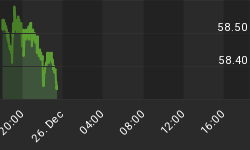Third quarter earnings have continued to disappoint investors. Roughly half of the S&P 500 companies (237) have reported third quarter earnings. Of those, earnings are flat with third quarter 2006. While 66.7% of companies have exceeded analysts' estimates, 22.8% have missed. Last year 73.1% were positive and only 10.6% missed analysts' estimates. Mixing in estimates for the remaining companies, third quarter earnings are expected to be down 1.5% compared to last year. Fourth quarter estimates remain relatively upbeat at up 9.9%.
Last week, several industrial companies reported earnings and issued guidance that disappointed investors. Caterpillar was one of the most notable ones. Third quarter earnings of $1.40, were two pennies shy of analysts' estimates. The lower than expected earnings were due to higher costs. Revenue was slightly better than estimates. Caterpillar now expects its core operating costs to increase by about $1 billion this year. Previously it expected an increase of $700 million. During its earnings conference call, Caterpillar gave a tepid outlook for next year, "We're expecting weak growth in U.S. with GDP at about 1.5% for the full year, which is well below the economy's potential and historic average growth rates. While we do expect additional rate cuts by the Fed, we don't expect much benefit to the economy or the industries we serve in 2008." The leading heavy equipment maker saw strength in its international operations, and forecasts that international strength will offset weakness in the US.
3M was another industrial company to provide lackluster earnings guidance. While 3M's third quarter earnings exceeded analysts' estimates by a penny, a lower tax rate provided a four cent benefit. Organic revenue growth slipped to 4.2% from 6.5% last quarter. US organic growth was only 1.2% compared to international organic growth of 6.3%. Multinationals have benefited from the weak dollar. 3M's sales were boosted by 3.1% due to currency translation and EPS was helped by about a nickel.
UPS provided a little relief early this week when it reported that third quarter earnings were better than Wall Street forecasts. US package deliveries increased about 1%, which was the first increase this year. It was all good news. The company expects "fourth-quarter domestic volumes to increase, but it will be the slowest fourth-quarter growth in the last four years."
Evidence that the consumer has weakened has continued to pile up. This week, Panera Bread, Cheesecake Factory and P.F. Chang's all either reported that third-quarter earnings were well below expectations or warned that future earnings would be lower than current forecast. P.F. Chang's reported third-quarter earnings that met previously reduced guidance and was cautious on future results. The company noted that it is slowing its expansion plans and will only open 43 new restaurants We have discussed before how decisions whether or not to hedge commodity prices are more difficult after prices have soared. Panera disclosed that it has decided not to hedge wheat costs anymore. While nobody knows if that is the correct decision, it will certainly lead to more volatility in earnings. To help offset higher food prices, the company is implementing a 2.5% price increase next month. Even with this price increase, comparable store sales are only expected to increase 1.0% to 3.5% this quarter. Company-wide same store sales increased 2.6% during the third quarter and comps have slowed in October. This would seem to question simple economics - raising price as demand wanes.
We have been discussing the poor monthly results retailers have reported over the past few months. This week, Talbot's announced that its third quarter results would be lower than previously articulated. The woman's retailer lowered guidance from $0.42-$0.48 per share to a loss of $0.25 go $0.35 per share. Comparable store sales were revised down from flat to down mid to high single digits. The company also expects to lose money during the fourth quarter, $0.05-$0.10 per share.
Luxury goods have been one of the better performing areas among retail. This might be changing. Coach reported strong third quarter earnings that were 32% better than last year driven by a 19.3% increase in same store sales. Factory store sales significantly outpaced retail stores, 27.3% compared to 10.2%. The company tempered its optimism by announcing that results during the current quarter have weakened. During the conference call the company said, "While we had initially expected that we could deliver another double-digit holiday season at retail, the recent deceleration in traffic and moderation in category growth from the torrid 20% growth levels we have seen since 2003 to a rate closer to 10% this fall led us to be more conservative in our outlook." Furthermore the company said it is "appropriate to target comparable-store sales of low single digits for our North American retail stores, while we believe that our factory stores will generate comps at least in the mid-teens."
During the first half of the year there was a general theme that multinational companies' weak domestic results were offset by the strength in their international operations. This was the result from the combination of a weak US dollar and strong global economic growth. While this theme has continued, it appears that domestic operations have eroded enough that international strength is not able to fully compensate. Fourth quarter earnings estimates remain optimistic, especially if consumer spending continues to slow. It is also very likely that the global economy will moderate much more than expected as consumer spending slows. Technology earnings have continued to be a relative safe-haven. It's doubtful that technology will be able to buck the trend with consumer spending slowing along with corporate profits. Or maybe, Apple will develop the iMortgage and save the housing market.
Due to other obligations, the next commentary will be published on November 15.















